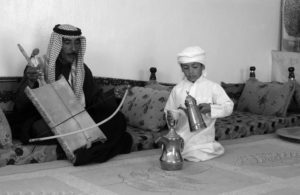Al Rababa
Al Rababa is an ancient folk stringed musical instrument, primarily used by praise poets. The rababa is often accompanied by Bedouin singing, especially in the Hijini and Shurqi musical style.
The rababa is a rectangular-shaped instrument with a wooden frame covered in skin. It has a single string attached to a peg at the top of the neck, which rests on a piece called “ghazal or Faras”. The rababa also contains seven horsehair strands that are attached from the beginning to the end, with those strands firmly secured in the middle. At the top of the rababa, there is a vertical wooden piece with four holes where four fingers of the hand are placed to play and produce an elegant sound (melody) as desired by the poet.
There is a story behind the invention of Al Rababa. It goes as follows:
There was a man who unfairly accused his wife of doing bad things and after he realized his mistake, he wanted to bring her back to his home. However, she refused his attempts to reconcile, to the point where she stipulated, “I will not return until the wooden stick speaks. The man was perplexed by her demand, so he sought the advice of a wise old woman from his tribe and told her what had happened. She said to him that the solution was simple: “Craft an instrument out of that wood and play it for her.” Thus, he made the rababa and sang to her.
Our daughter with four rings in her ears is clearly shown by the whole world from east to west. The Rababa was said to have four holes where the singer plays with his fingers.


